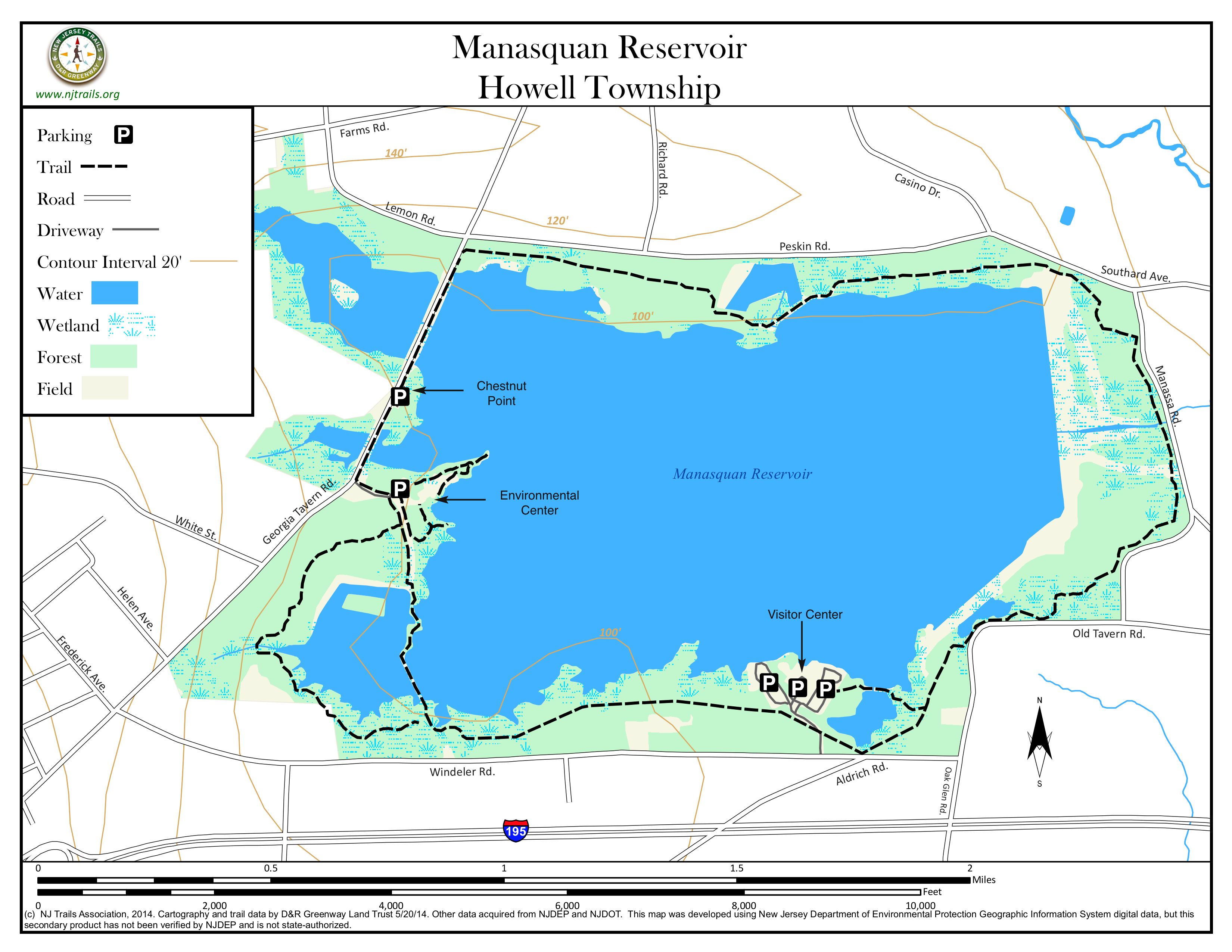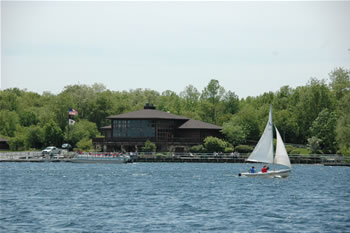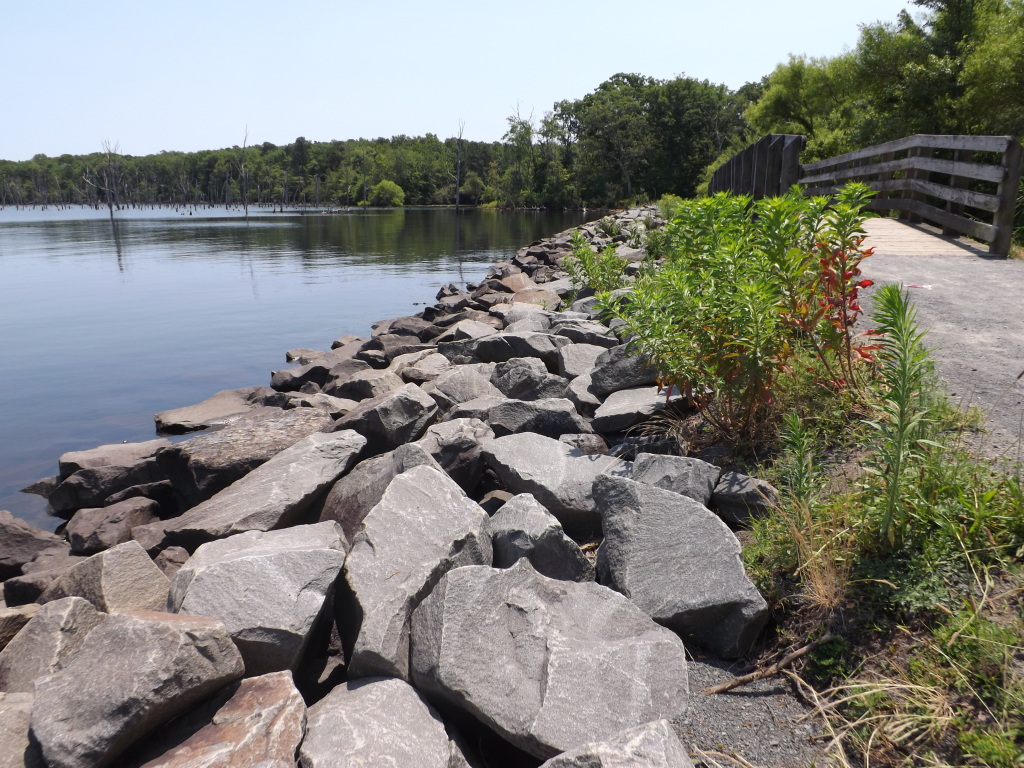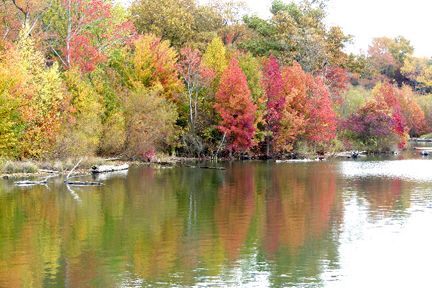Monmouth
Howell Township
Manasquan Reservoir
Howell Township, NJ 07731



Last Updated: 01/24/2018
Overview of Selected Trail
The Manasquan Reservoir Park encompasses a total of 1,200 acres including the reservoir itself and surrounding forests and wetlands. The reservoir is a source of water for municipalities and utilities, but also offers some of the best outdoor recreation opportunities in Monmouth County. There is a five-mile perimeter trail, partly in shade, for hiking, biking, running, horseback riding and wildlife study, and the reservoir can be used for fishing and boating (electric motors only). A Visitor Center and Environmental Center provide information on the park, and more information can be found at Monmouth County Parks.
-

-
Distance:
A single five-mile loop
Time:
Plan for 1-2 hours to complete the full loop.
Markings:
The single perimeter trail is unmarked, but easy to follow. There are benches scattered throughout the trail route and spectacular views of the Reservoir.
Trail Usage:
Walking/Hiking, Horseback Riding, Mountain Biking
Elevation:
This trail loops all the way around the reservoir and has a fairly even, well-maintained surface.
Difficulty:
Easy
Parking:
Ample parking is available at the Environmental Education Center and the Chestnut Point parking areas entered off Georgia Tavern Road, and at the Visitor Center entered off Windeler Road.
Tips:
An additional 1.1 mile Cove Trail that circles a wetland area, is a scenic nature trail that explores the lakeshore around the Environmental Center and is open to pedestrians only.
Open 6:00am to dusk April 1 – October 31 and 7:00am to dusk from November 1 to March 31.
The Visitor Center is open during regular park hours. Telephone: (732) 919-0996
The Environmental Center is open every day from 10:00am-4:30pm; Summer hours are 10:00am-5:00pm and 10:00am to 8:30pm on Fridays. Telephone: (732) 751-9453
For Visitor Center and Boat Docks: Follow Georgia Tavern Rd. for .3 miles, turn right onto Winderler Rd., continue for 1.5 miles to entrance on left.
All vessels are launched from the Visitor Center and require purchase of daily or seasonal launch pass (sold on site).
Rentals available April 1 – October 31
Amenities:
1,204 acres of land and water
Fishing
5-mile perimeter trail
1-mile nature trail
Playground
Ice-skating
Kayak and rowboat rentals
Six created wetlands
Trailside wildlife meadowsDirections:
From northern or southern New Jersey:
Take the Garden State Parkway to Exit 98 and take 195 west (I-195), or from central Jersey take I-195 west. In either case, leave I-195 at Exit 28B (Route 9 north) towards Freehold. Stay in the right lane on Route 9, and at the first traffic light, turn right onto Georgia Tavern Road. Follow Georgia Tavern Road for one mile to the Environmental Center on right. Alternatively, before getting to the Environmental Center, turn right on Windeler Road and continue about 1.5 miles to the park entrance, on the left, leading to the Visitor Center.
If approaching from Freehold, take State Route 9 South and use the jughandle to turn left onto Georgia Tavern Road. Continue one mile to the Environmental Center entrance on the right. For the Visitor Center entrance, take Windeler Road to the right before reaching the Environmental Center.
-
The five-mile trail around the Manasquan Reservoir has three possible starting points: the Environmental Center, the Visitor Center, and the Chestnut Point parking area. If you start at the Environmental Center, be sure to browse the exhibits. A telescope is set up to view the reservoir. In the past, there has been a pair of eagles nesting across the Reservoir. In the summer months foliage may obscure the view.
The trail entrance is at the end of the parking lot near the Environmental Center, and is unmarked, but the six-foot wide, gray gravel trail is easy to locate. The description below assumes the walker is going clockwise around the reservoir, heading first north along Georgia Tavern Road.
Walking north, with a fence between the trail and the road, you approach the Chestnut Point parking lot (another entrance to the perimeter trail), and the whole reservoir comes into view. The trail curves away from the road, with trees on both sides, and a fence blocking a restricted area between the trail and reservoir. This part of the trail has thicker woods than other areas, and many small curves. Take notice of the wildlife habitats and duck pond on your left. Pass into a stretch of trail surrounded by low brush, and note a “3-mile” marker. After crossing pavement and passing a gated road leading into the reservoir, the trail leads into a woodland area and away from the reservoir, along Peskin Road and across a stream on a wooden bridge. You will have to go around the side of a wooden gate and cross pavement, and pass a second wooden gate. The trail then climbs a bit, yielding a broad view of the water on your right as you cross another wooden bridge. Next, the trail leads into the Visitor Center parking lot, where there is has another entrance to the perimeter trail, marked at the back of the parking lot. From this point it is about another mile back to the Environmental Center. The trail leads through woods until you cross a few boardwalks and it becomes a sand path back to the Environmental Center parking lot where you began.
-
The Manasquan Reservoir provides excellent opportunities to view species in their natural habitats. Wetland and woodland trees include oak, dogwood, birch, pitch pine, American holly, sweetgum, and black cherry. Many herbaceous plants and vines are visible, including black raspberry, greenbrier and sweet fern. Bald eagles, great blue herons, ospreys, and double-crested cormorants are among the 200 species of birds found at the reservoir. Numerous dragonfly and aquatic insects, and most species of butterflies and moths found in Monmouth County can be seen. Larger butterfly species, like swallowtails, are the most visible. Visitors may see deer, red fox, chipmunk, woodchuck, raccoon and eastern tail rabbit, and the reservoir is home to many species of turtles, snakes and frogs. More than 20 varieties of fish, 20 types of mammals, and 25 different reptiles and amphibians also inhabit the reservoir and its surroundings.
Do you have information about this trail?
Click Here to contribute.
-
Ancient artifacts found in the reservoir area suggest that the Lenape Indians lived in the vicinity or passed through. Hardwood forests prevailed, and in later times were harvested for furniture. Still later, the land was used for chicken farming.
The Manasquan Reservoir was designed in 1985 and built between 1987 and 1989, to provide water for municipalities and utilites. With a 4 billion-gallon high water capacity and a maximum 40-foot depth, the reservoir can supply up to 30 million gallons of water a day. Water from the Manasquan River is pumped more than five miles to the 770-acre reservoir through a 66-inch pipeline, reducing the amount of water drawn from underground aquifers.
In 1990, the Monmouth County Parks System entered a 99 year lease with the water authority to manage recreation activities at the reservoir, opening the Visitor Center in 1994, with its wonderful views of the reservoir from an observation deck, a canoe and kayak rental and bait shop, and picnic benches and a children’s play area nearby. The Environmental Center, opened in 2002, provides learning experiences related to watersheds, wetlands ecology, wildlife, and habitat protection through exhibits, multi-media presentations, wildlife observation areas, and a variety of nature programs from eagle viewing to pond studies for individuals, schools, and community groups.
Do you have information about this trail?
Click Here to contribute.
-
Photos
Videos



